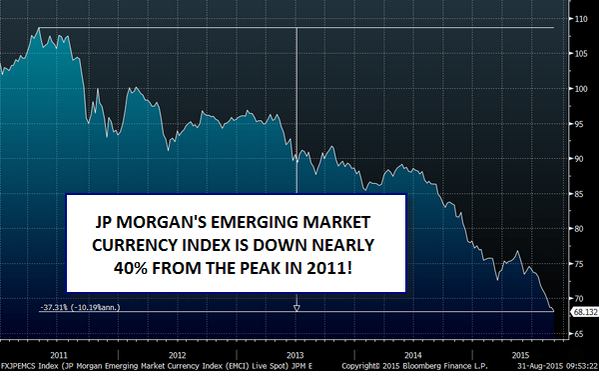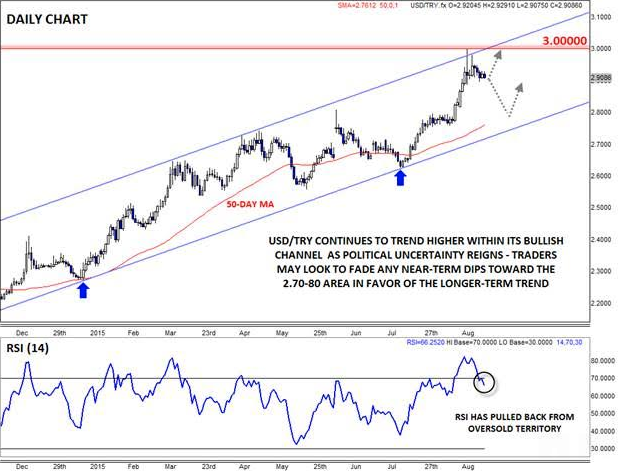For most asset classes, the panic-driven moves of last Monday have been erased, with EURUSD completing its 500-pip round trip, US equities actually closing higher last week and yield on the benchmark 10-year US treasury bond quickly bouncing back to the 2.20% range. However, emerging market currencies haven’t been nearly as lucky; indeed, the JP Morgan Emerging Market Currency Index has continued hit new multi-year lows as August winds down:

Source: FOREX.com, Bloomberg
Currencies like the Brazilian real, Russian ruble, Turkish lira and South African rand have acted as particularly heavy anchors for the index, but almost every emerging market currency has fallen against the US dollar of late. The strong correlation between emerging-market currencies is likely to continue into this week, especially if the top-tier US data is consistently bullish (suggesting that the Federal Reserve is more likely to raise interest rates in September, putting further stress on EM FX) or bearish (tipping the scales toward the Fed holding off until December or later before hiking rates). That said, there are still two specific areas to focus on in EM FX this week:
USD/RUB: CPI and Putin’s Trip to China
One of those areas is undoubtedly in Russia, where traders will get their first look at the August consumer price index (CPI) on Friday. Given the recent weakness in the currency this month, the country’s already-elevated 15.6% annual rate of inflation could even accelerate further. Beyond that traditional economic data release, there is also the potential for geopolitical volatility, as Russian President Putin will visit China on Tuesday and Wednesday to discuss bilateral oil and gas contracts. With ties between the two countries seemingly growing tighter of late, we could see a new trade agreement, or at least rumors of one, emerge later this week.
For its part, the Russian ruble has been whipped this way and that amidst volatile oil prices over the last week. But the longer-term trend remains toward ruble weakness. As of writing, USD/RUB is trading at just 63.60, down from above 70.00 early last week, but the pair’s bullish trend line and 50-day MA around 60.00-61.00 could provide support if the pair continues to dip.
USD/TRY: Political Uncertainty Lingers
Last week, Turkish President Erdogan approved the caretaker government that will govern until the November 1 snap election. This election was called when the country was unable to form a coalition government after its last general election in June. Confused yet? So are many traders. As you would expect, the ongoing political uncertainty has been one of the primary factors driving USD/TRY to a new all-time high above the 3.00 level just two weeks ago.
The pair has come off its recent highs of late, but the medium- and longer-term trends still remain higher, so traders may favor fading any near-term dips. To the downside, support is likely to emerge near the 50-day MA (just below the 2.80 level) and the bottom of the recent bullish channel near 2.70. Above, the 3.00 level could provide important psychological resistance, but if that level gives way, a continuation up to 3.10 or higher is definitely in play.

Source: FOREX.com
